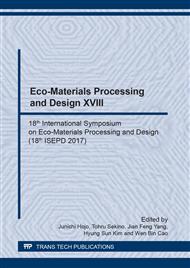[1]
A. Amanov, Y. S. Pyun, J. H. Kim, S. Sasaki, Enhancement in wear resistance of sintered silicon carbide at various temperatures, Tribo. Int. 74 (2014) 28-37.
DOI: 10.1016/j.triboint.2014.01.027
Google Scholar
[2]
S. Xu, G. Qiao, D. Li, H. Yang, Y. Liu, T. Lu, Reaction forming of silicon carbide ceramic using phenolic resin derived porous carbon perform, J. Eur. Ceram. Soc. 29 (2009) 2395–2402.
DOI: 10.1016/j.jeurceramsoc.2009.01.022
Google Scholar
[3]
M. Esfehanian, J. Guenster, J.G. Heinrich, J. Horvath, D. Koch, G. Grathwohl, High-temperature mechanical behavior of carbon–silicide–carbide composites developed by alloyed melt infiltration, J. Eur. Ceram. Soc. 28 (2008) 1267–1274.
DOI: 10.1016/j.jeurceramsoc.2007.09.053
Google Scholar
[4]
S.Y. Kim, I. S. Han, S.K. Woo, K. S. Lee, D.K. Kim, Wear-mechanical properties of filler-added liquid silicon infiltration C/C–SiC composites, Mater. Des. 44 (2013) 107–113.
DOI: 10.1016/j.matdes.2012.07.064
Google Scholar
[5]
Z. Stadler, K. Krnel, T. Kosmac, Friction behavior of sintered metallic brake pads on a C/C-SiC composite brake disc, J. Eur. Ceram. Soc. 27(2007) 1411–1417.
DOI: 10.1016/j.jeurceramsoc.2006.04.032
Google Scholar
[6]
M Kermc, M. Kalin, J. Vizintin, Development and use of an apparatus for tribological evaluation of ceramic-based brake materials, Wear 259 (2005) 1079–1087.
DOI: 10.1016/j.wear.2004.12.002
Google Scholar
[7]
S. Safi, A. Kazemzadeh, MCMB-SiC composites; new class high-temperature structural material for aerospace applications, Ceram. Int. 39 (2013) 81–86.
DOI: 10.1016/j.ceramint.2012.05.098
Google Scholar
[8]
H. Xia, J. Wang, Z. Shi, G. Qiao, Reciprocating friction and wear properties of mesocarbon microbeads-based graphite and siliconized graphite, J. Nucl. Mater. 433 (2013) 341–344.
DOI: 10.1016/j.jnucmat.2012.09.016
Google Scholar
[9]
Y. Wang, S. Tan, D. Jiang, The effect of porous carbon preform and the infiltration process on the properties of reaction-formed SiC, Carbon 42 (2004) 1833–1839.
DOI: 10.1016/j.carbon.2004.03.018
Google Scholar
[10]
N.R. Calderon, M. Martínez-Escandell, J. Narciso, F. Rodríguez-Reinoso, The combined effect of porosity and reactivity of the carbon preforms on the properties of SiC produced by reactive infiltration with liquid Si, Carbon 47 (2009) 2200-2210.
DOI: 10.1016/j.carbon.2009.04.002
Google Scholar
[11]
Z. Yang, X. He, M. Wu, L. Zhang , A. Ma, R. Liu , H. Hu, Y. Zhang , X. Qu, Infiltration mechanism of diamond/SiC composites fabricated by Si-vapor vacuum reactive infiltration process, J. Eur. Ceram. Soc. 33 (2013) 869–878.
DOI: 10.1016/j.jeurceramsoc.2012.09.010
Google Scholar
[12]
S. Kumar, A. Kumar, A. Shukla, A.K. Gupta, R. Devi, Capillary infiltration studies of liquids into 3D-stitched C–C preforms Part A: Internal pore characterization by solvent infiltration, mercury porosimetry, and permeability studies, J. Eur. Ceram. Soc. 29 (2009).
DOI: 10.1016/j.jeurceramsoc.2009.03.006
Google Scholar
[13]
S. Kumar, A. Kumara, R. Devi, A. Shukla, A.K. Gupta, Capillary infiltration studies of liquids into 3D-stitched C–C preforms Part B: Kinetics of silicon infiltration, J. Eur. Ceram. Soc. 29 (2009) 2651–2657.
DOI: 10.1016/j.jeurceramsoc.2009.03.006
Google Scholar
[14]
Y.Zhao, H. Xia, R.Tang, Z. Shi, J. Yang, J. Wang, A low cost preparation of C/SiC composites by infiltrating molten Si into gelcasted pure porous carbon preform, Ceram. Int. 41 (2015) 6478–6487.
DOI: 10.1016/j.ceramint.2015.01.087
Google Scholar
[15]
I. Mochida, Y. Korai, C.H. Ku, F. Watanabe, Y. Sakai, Chemistry of synthesis, structure, preparation and application of aromatic-derived mesophase pitch, Carbon 38 (2000) 305–328.
DOI: 10.1016/s0008-6223(99)00176-1
Google Scholar
[16]
H. Xia, J. Wang, B. Huang, Z. Shi, G. Liu, G. Qiao, The influence of ball-milling on improving the performance of mesocarbon microbeads based carbon blocks, Mater. Sci. Eng. A. 529 (2011) 282–288.
DOI: 10.1016/j.msea.2011.09.030
Google Scholar
[17]
S. Safi, R. Yazdani Rad, In situ synthesis of nano size silicon carbide and fabrication of C-SiC composites during the siliconization process of mesocarbon microbeads performs, Ceram. Int. 38 (2012) 5081-5087.
DOI: 10.1016/j.ceramint.2012.03.010
Google Scholar
[18]
Y.G. Wang, Y. Korai, I. Mochida, Carbon disc of high density and strength prepared from synthetic pitch-derived mesocarbon microbeads, Carbon 37 (1999) 1049–1057.
DOI: 10.1016/s0008-6223(98)00298-x
Google Scholar


